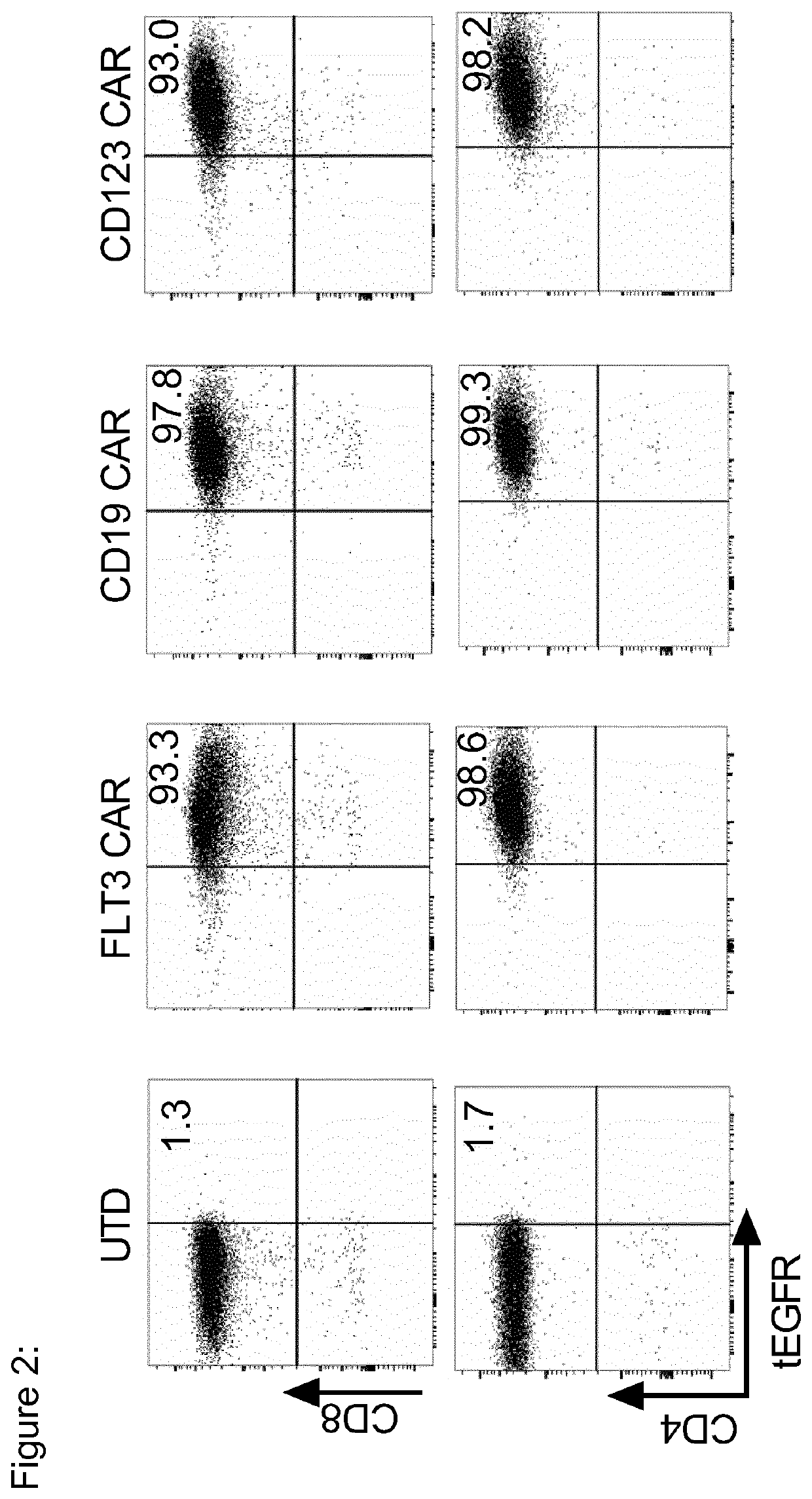Use of flt3 car-t cells and flt3 inhibitors to treat acute myeloid leukemia
a technology of acute myeloid leukemia and car-t cells, which is applied in the field of cancer treatment with flt3 targeting agents and kinase inhibitors, can solve the problems of limited clinical efficacy of single agent therapy with ‘first-generation’ flt3 inhibitors
- Summary
- Abstract
- Description
- Claims
- Application Information
AI Technical Summary
Benefits of technology
Problems solved by technology
Method used
Image
Examples
example 1
[0274]Materials and Methods
[0275]Human Subjects
[0276]Peripheral blood was obtained from healthy donors and adult AML patients after written informed consent to participate in research protocols approved by the Institutional Review Board of the participating institutions.
[0277]Primary AML Cells
[0278]Primary AML cells were maintained in RPMI-1640 supplemented with 10% human serum, 2 mM glutamine, 100 U / mL penicillin / streptomycin, and a cytokine cocktail including IL-4 (1000 IU / mL), granulocyte macrophage colony-stimulating factor (GM-CSF) (10 ng / mL), stem cell factor (5 ng / mL) and tumor necrosis factor (TNF)-α (10 ng / mL).
[0279]Tumor Cell Lines
[0280]The human leukemia cell lines MOLM-13 (ACC 554), THP-1 (ACC 16), MV4;11 (ACC 102), and K562 (ACC 10) were purchased from DSMZ (Deutsche Sammlung von Mikroorganismen and Zellkulturen, Braunschweig, Germany) and cultured in RPMI-1640 supplemented with 10% fetal calf serum (FCS), 2 mM glutamine and 100 U / mL penicillin / streptomycin. All cell li...
example 2
[0325]Materials and Methods:
[0326]Human Subjects
[0327]Peripheral blood was obtained from healthy donors and adult AML patients after written informed consent to participate in research protocols approved by the Institutional Review Board of the participating institutions.
[0328]Primary AML Cells
[0329]Primary AML cells were maintained in RPMI-1640 supplemented with 10% human serum, 2 mM glutamine, 100 U / mL penicillin / streptomycin, and a cytokine cocktail including IL-4 (1000 IU / mL), granulocyte macrophage colony-stimulating factor (GM-CSF) (10 ng / mL), stem cell factor (5 ng / mL) and tumor necrosis factor (TNF)-α (10 ng / mL).
[0330]Tumor Cell Lines
[0331]The human leukemia cell lines MOLM-13 (ACC 554), THP-1 (ACC 16), MV4;11 (ACC 102), and K562 (ACC 10) were purchased from DSMZ (Deutsche Sammlung von Mikroorganismen and Zellkulturen, Braunschweig, Germany) and cultured in RPMI-1640 supplemented with 10% fetal calf serum (FCS), 2 mM glutamine and 100 U / mL penicillin / streptomycin. All cell l...
example 3
[0370]Materials and Methods:
[0371]Human Subjects
[0372]Peripheral blood was obtained from healthy donors after written informed consent to participate in research protocols approved by the Institutional Review Board of the University of Würzburg.
[0373]Tumor Cell Lines
[0374]The human leukemia cell lines MOLM-13 (ACC 554) was purchased from DSMZ (Deutsche Sammlung von Mikroorganismen and Zellkulturen, Braunschweig, Germany) and cultured in RPMI-1640 supplemented with 10% fetal calf serum (FCS), 2 mM glutamine and 100 U / mL penicillin / streptomycin. MOLM-13 cells were transduced with a lentiviral vector encoding a firefly luciferase (ffluc)_green fluorescent protein (GFP) transgene to enable detection by flow cytometry (GFP) and bioluminescence imaging (ffLuc) in mice, and bioluminescence-based cytotoxicity assays.
[0375]Flow Cytometric Analysis of FLT3 Expression
[0376]Cell surface expression of FLT3 was analyzed using a conjugated mouse-anti-human-FLT3 mAb (clone 4G8, BD Biosciences, Germ...
PUM
| Property | Measurement | Unit |
|---|---|---|
| concentration | aaaaa | aaaaa |
| molecular weight | aaaaa | aaaaa |
| composition | aaaaa | aaaaa |
Abstract
Description
Claims
Application Information
 Login to View More
Login to View More - R&D
- Intellectual Property
- Life Sciences
- Materials
- Tech Scout
- Unparalleled Data Quality
- Higher Quality Content
- 60% Fewer Hallucinations
Browse by: Latest US Patents, China's latest patents, Technical Efficacy Thesaurus, Application Domain, Technology Topic, Popular Technical Reports.
© 2025 PatSnap. All rights reserved.Legal|Privacy policy|Modern Slavery Act Transparency Statement|Sitemap|About US| Contact US: help@patsnap.com



